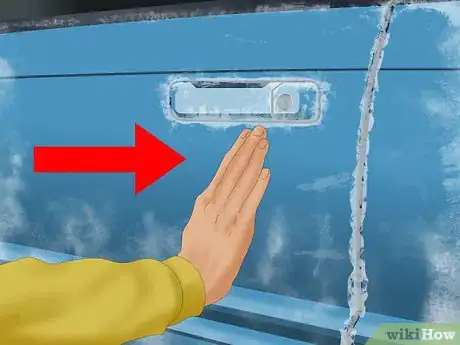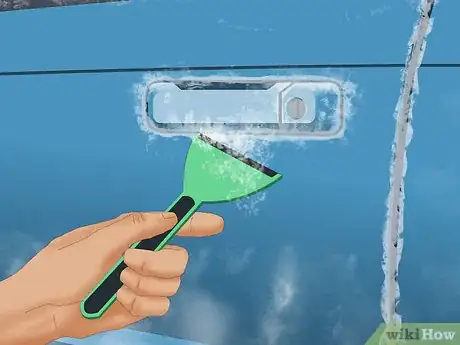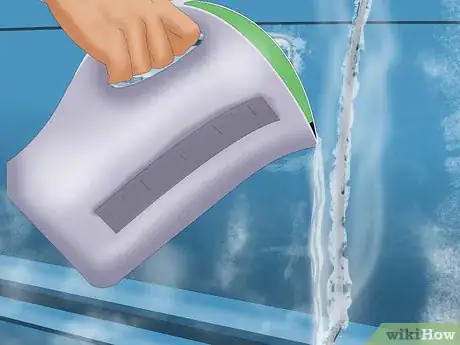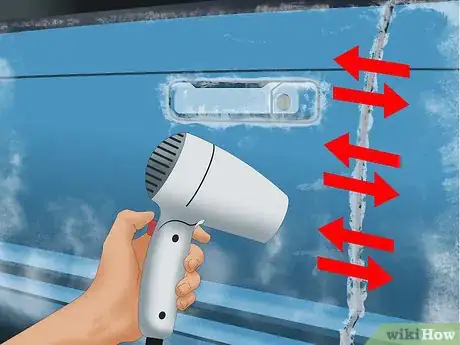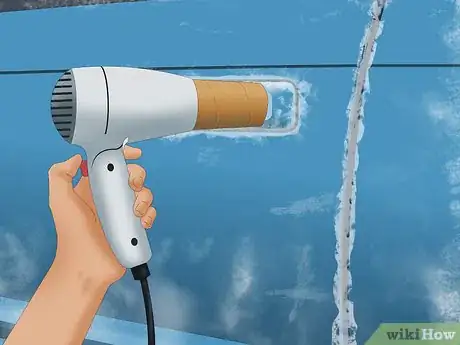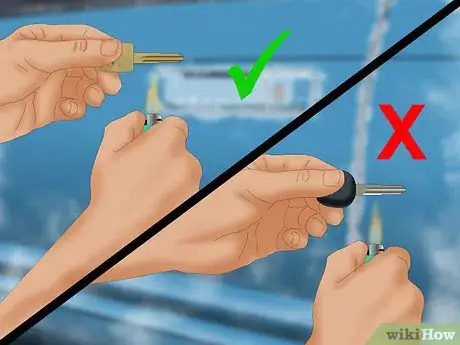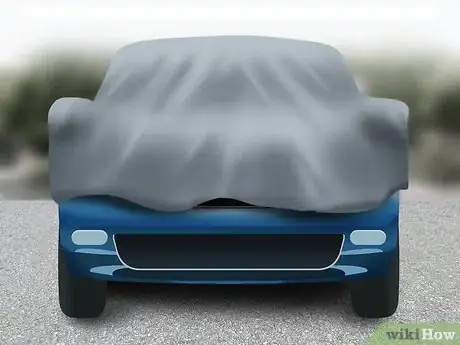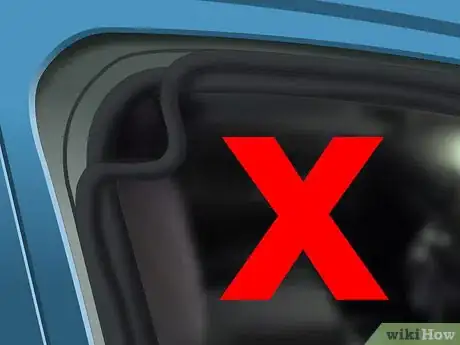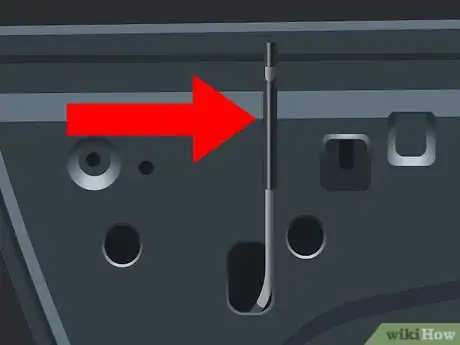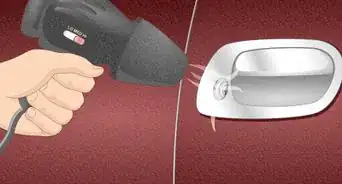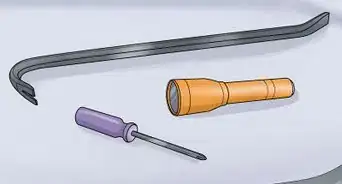This article was co-authored by wikiHow Staff. Our trained team of editors and researchers validate articles for accuracy and comprehensiveness. wikiHow's Content Management Team carefully monitors the work from our editorial staff to ensure that each article is backed by trusted research and meets our high quality standards.
There are 7 references cited in this article, which can be found at the bottom of the page.
wikiHow marks an article as reader-approved once it receives enough positive feedback. This article received 13 testimonials and 86% of readers who voted found it helpful, earning it our reader-approved status.
This article has been viewed 775,384 times.
Learn more...
Car doors freeze shut when water seeps between the seal and the car frame, or into the lock itself. To get inside your car, you'll need to dissolve the ice with heat, or with a solvent such as alcohol.
Steps
Unfreezing Door Seals or Handles
-
1Push on your car door. Apply pressure by leaning on your frozen door. Push as hard as you can against the door. The pressure could break the ice around the door's seal, enabling you to open the door.
- This section assumes you can unlock your car, but not open it. If the lock itself is frozen, skip to the section below.
-
2Chip away the ice. If the ice has formed a thick crust, break it off the seal of the door on all sides, and off the handle if necessary. If you don't have an ice scraper, use any stiff plastic object, such as a spatula or credit card. Metal objects may scratch the glass or paint.Advertisement
-
3Pour lukewarm water over the rubber seals. Fill a cup, bucket or another container with lukewarm water. Pour the water around the seal of the door to thaw the ice. You may need to repeat this several times if the ice is thick. Once the door is open, dry off the inside of the seal with a towel to prevent re-freezing.
- Never use hot water, or the temperature difference could shatter your window glass. Even cold water from the hose can do the trick, since it is warmer than the ice.[1]
- Car doors most often freeze where the rubber seal is worn or damaged, allowing water to seep in and freeze. If you notice any damage, focus on that area while pouring.
-
4Spray on commercial de-icer. You can find de-icer products at auto shops and hardware stores. These both dissolve the ice, and leave lubricant behind to help prevent further moisture from collecting.[2] In a pinch, you can substitute a homemade mixture:
- Rubbing alcohol can dissolve ice, but repeated use may damage your rubber gasket.
- Some varieties of windshield wiper fluid are mostly alcohol, and can serve the same purpose.
- Diluted white vinegar is a last resort, as it leaves a lingering smell and — according to some — may leave pock marks on the window glass.[3]
-
5Start the car remotely. If you have a remote car starter, use it and let the heat thaw the car door from the inside. This could take up to 10 minutes.
-
6Heat the frozen seal with a blow dryer. If you have a battery-operated model or an extension cord long enough to reach your car, this is another DIY way to melt the ice — but potentially a hazardous one. Move the blow dryer constantly back and forth across the door seal. Too much heat in one spot could break the glass, especially if there are existing cracks or chips.[4]
Unfreezing Car Locks
-
1Spray lubricant on the key or lock. This works best if you spray the key, or place a straw against the lock and spray through the straw. You may use any of the following:[5]
- Commercial deicer
- Rubbing alcohol
- PTFE powder lubricant (best for prevention)
- Warning: avoid WD40, grease lubricant, and silicone lubricant, which can gum up the lock. Graphite is safe in small quantities.
- Do not combine multiple lubricants.[6]
-
2Blow warm air into the lock. Place a cardboard toilet paper roll or another cylindrical object over the lock to direct the air. Heat the lock by blowing into the roll with your breath or a blow dryer.[7] This may take some time.
-
3Heat the key. Only try this if the key is 100% metal and does not contain an electronic chip. Hold the key with thick gloves or tongs, and heat it above a match or lighter. Insert the key into the lock and wait for the ice to thaw.
Preventing Frozen Doors
-
1Cover your car. After parking outside, cover the car with a tarp to keep ice off the doors, locks, and windshield.[8] Cover the hood as well in extreme weather conditions to prevent more serious malfunction.
-
2Shut a plastic trash bag in the door. Before closing your door in icy weather, place a trash bag between the door and the frame so they cannot freeze together.
-
3Wipe a protective product over the rubber seals. It's best to use a special rubber conditioner from an auto shop.[9] Silicone spray is usually fine, but may damage silicone rubber, so consider checking with the car manufacturer first. Petroleum products and cooking spray are common DIY options, but they can wear down the rubber over time.
-
4Replace damaged gaskets. Have your rubber door seals replaced if you see any tears. These let water seep in and freeze your door shut.
-
5Check your locking rods. If you are able to remove your door panel, do so and investigate the rod that operates the lock. If it looks icy or corroded, spray it with de-icer.[10] An auto shop can do this for you if you prefer.
Community Q&A
-
QuestionIf I use warm water, is there any danger of it refreezing from long-term subzero temperatures?
 Community AnswerYes. Dry the door frame and rubber with an old towel after you get the door open.
Community AnswerYes. Dry the door frame and rubber with an old towel after you get the door open. -
QuestionIs a 'Preston Window De-Icing Spray' okay for thawing rubber door seals/car locks?
 Terrence MacArthurCommunity AnswerCheck the labe to see if it's safe to use with rubber. Since windshields have rubber seals, it probably is.
Terrence MacArthurCommunity AnswerCheck the labe to see if it's safe to use with rubber. Since windshields have rubber seals, it probably is. -
QuestionCan I use Vaseline on rubber?
 Community AnswerYou can't use Vaseline on the shaft, but you can use it on the rubber.
Community AnswerYou can't use Vaseline on the shaft, but you can use it on the rubber.
Warnings
- Avoid washing your car in cold weather to reduce the chance of water entering the door.⧼thumbs_response⧽
Things You'll Need
- De-icer or rubbing alcohol
- Lukewarm water
- Ice scraper
- Dry lubricant
- Trash bag
References
- ↑ http://www.bizjournals.com/denver/stories/2009/12/07/daily38.html
- ↑ http://www.catalogs.com/info/automotive/open-a-frozen-car-door.html
- ↑ http://www.snopes.com/inboxer/household/vinegar.asp
- ↑ http://fox2now.com/2013/12/05/blasting-heat-on-frozen-windshield-can-break-glass/#
- ↑ http://ricksfreeautorepairadvice.com/frozen-car-door-lock/
- ↑ https://www.yourmechanic.com/article/how-to-prevent-car-doors-from-freezing-shut
- ↑ https://www.southpa.aaa.com/news/traffic-safety/tips-avoid-frozen-locks-and-doors
- ↑ https://www.southpa.aaa.com/news/traffic-safety/tips-avoid-frozen-locks-and-doors
- ↑ https://www.yourmechanic.com/article/how-to-prevent-car-doors-from-freezing-shut
About This Article
To open frozen car doors, push on the frozen door to see if the pressure breaks the ice around the door’s seal. If the ice has formed a thick crust, then break it off the seal of the door with an ice scraper, spatula, or credit card. Alternatively, you can pour lukewarm water over the rubber seal of the door, or set up an extension cord to run a hairdryer around the door's seal. Additionally, if you have a remote starter, then let the heat thaw the car door from the inside, which can take up to 10 minutes. To learn how to unfreeze car locks, keep reading!
